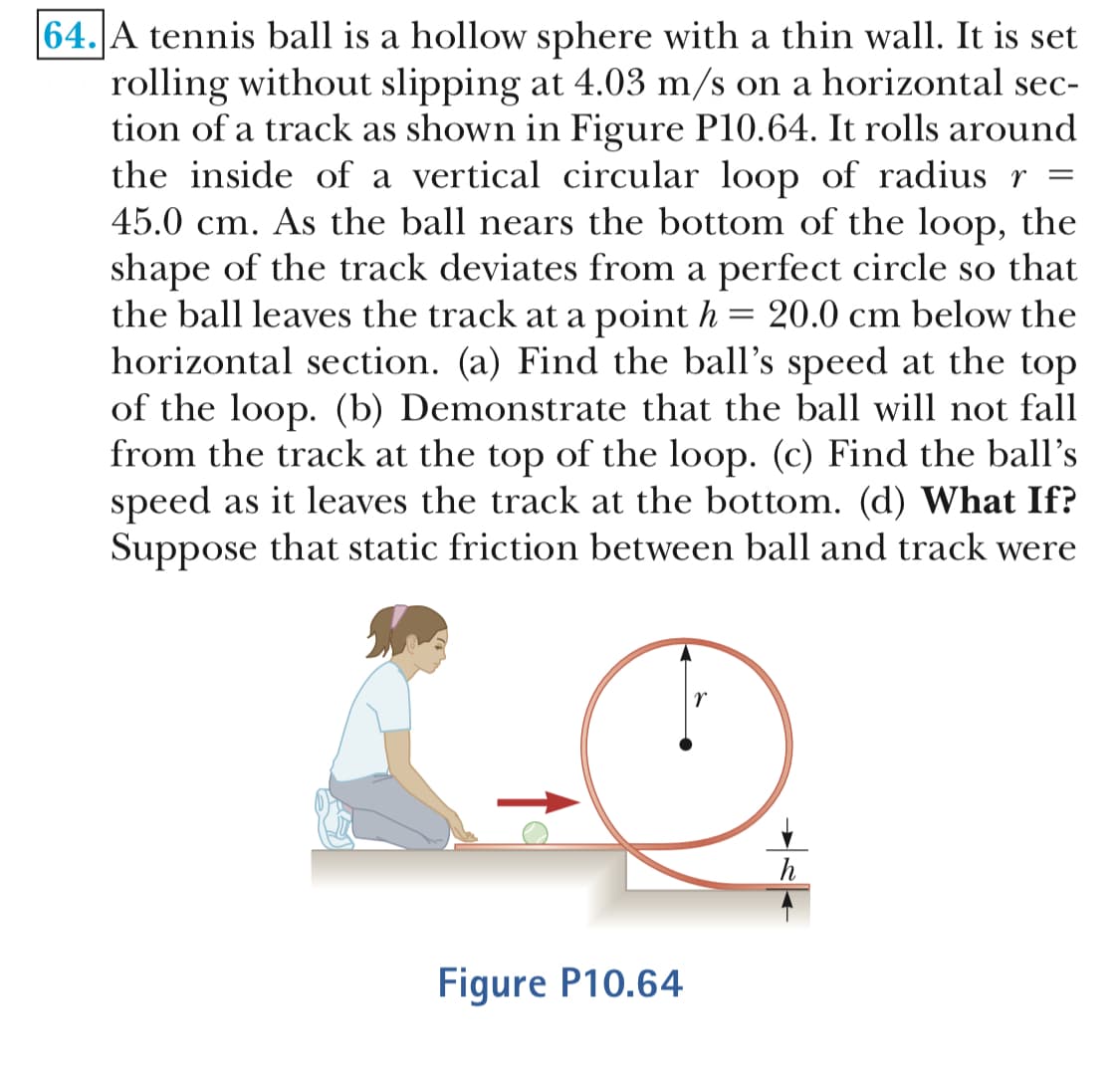64.A tennis ball is a hollow sphere with a thin wall. It is set rolling without slipping at 4.03 m/s on a horizontal sec- tion of a track as shown in Figure P10.64. It rolls around the inside of a vertical circular loop of radius r- 45.0 cm. As the ball nears the bottom of the loop, the shape of the track deviates from a perfect circle so that the ball leaves the track at a point h- 20.0 cm below the horizontal section. (a) Find the ball's speed at the top of the loop. (b) Demonstrate that the ball will not fall from the track at the top of the loop. (c) Find the ball's speed as it leaves the track at the bottom. (d) What If? Suppose that static friction between ball and track were Figure P10.64
64.A tennis ball is a hollow sphere with a thin wall. It is set rolling without slipping at 4.03 m/s on a horizontal sec- tion of a track as shown in Figure P10.64. It rolls around the inside of a vertical circular loop of radius r- 45.0 cm. As the ball nears the bottom of the loop, the shape of the track deviates from a perfect circle so that the ball leaves the track at a point h- 20.0 cm below the horizontal section. (a) Find the ball's speed at the top of the loop. (b) Demonstrate that the ball will not fall from the track at the top of the loop. (c) Find the ball's speed as it leaves the track at the bottom. (d) What If? Suppose that static friction between ball and track were Figure P10.64
Principles of Physics: A Calculus-Based Text
5th Edition
ISBN:9781133104261
Author:Raymond A. Serway, John W. Jewett
Publisher:Raymond A. Serway, John W. Jewett
Chapter10: Rotational Motion
Section: Chapter Questions
Problem 62P: A tennis ball is a hollow sphere with a thin wall. It is set rolling without slipping at 4.03 m/s on...
Related questions
Question

Transcribed Image Text:64.A tennis ball is a hollow sphere with a thin wall. It is set
rolling without slipping at 4.03 m/s on a horizontal sec-
tion of a track as shown in Figure P10.64. It rolls around
the inside of a vertical circular loop of radius r-
45.0 cm. As the ball nears the bottom of the loop, the
shape of the track deviates from a perfect circle so that
the ball leaves the track at a point h- 20.0 cm below the
horizontal section. (a) Find the ball's speed at the top
of the loop. (b) Demonstrate that the ball will not fall
from the track at the top of the loop. (c) Find the ball's
speed as it leaves the track at the bottom. (d) What If?
Suppose that static friction between ball and track were
Figure P10.64
Expert Solution
This question has been solved!
Explore an expertly crafted, step-by-step solution for a thorough understanding of key concepts.
This is a popular solution!
Trending now
This is a popular solution!
Step by step
Solved in 7 steps with 5 images

Recommended textbooks for you

Principles of Physics: A Calculus-Based Text
Physics
ISBN:
9781133104261
Author:
Raymond A. Serway, John W. Jewett
Publisher:
Cengage Learning

Physics for Scientists and Engineers with Modern …
Physics
ISBN:
9781337553292
Author:
Raymond A. Serway, John W. Jewett
Publisher:
Cengage Learning

Physics for Scientists and Engineers
Physics
ISBN:
9781337553278
Author:
Raymond A. Serway, John W. Jewett
Publisher:
Cengage Learning

Principles of Physics: A Calculus-Based Text
Physics
ISBN:
9781133104261
Author:
Raymond A. Serway, John W. Jewett
Publisher:
Cengage Learning

Physics for Scientists and Engineers with Modern …
Physics
ISBN:
9781337553292
Author:
Raymond A. Serway, John W. Jewett
Publisher:
Cengage Learning

Physics for Scientists and Engineers
Physics
ISBN:
9781337553278
Author:
Raymond A. Serway, John W. Jewett
Publisher:
Cengage Learning

Physics for Scientists and Engineers: Foundations…
Physics
ISBN:
9781133939146
Author:
Katz, Debora M.
Publisher:
Cengage Learning

University Physics Volume 1
Physics
ISBN:
9781938168277
Author:
William Moebs, Samuel J. Ling, Jeff Sanny
Publisher:
OpenStax - Rice University

Physics for Scientists and Engineers, Technology …
Physics
ISBN:
9781305116399
Author:
Raymond A. Serway, John W. Jewett
Publisher:
Cengage Learning